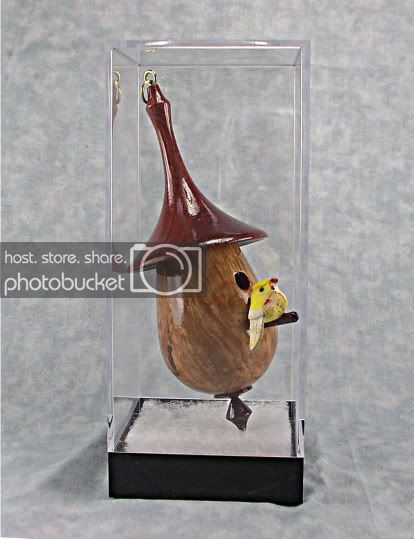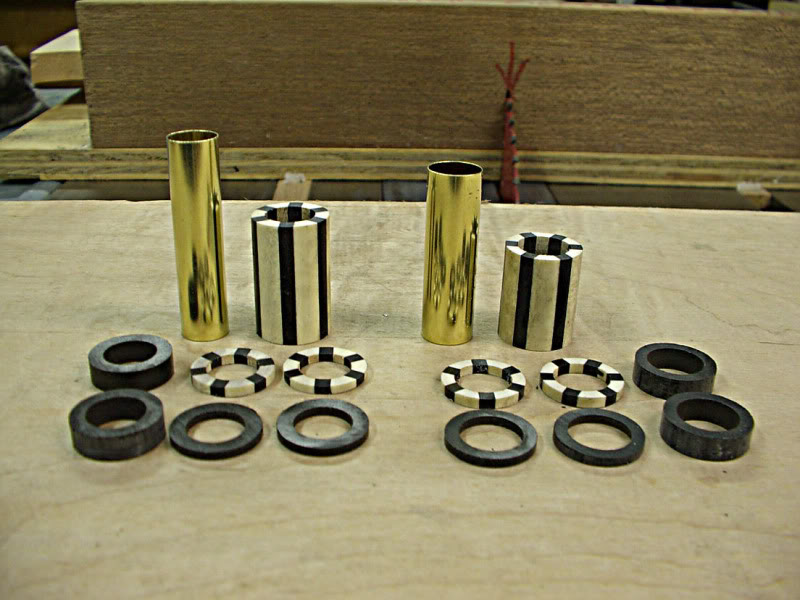I am going to turn some Christmas ornaments, to be enhanced with the Woodturningz finial set. (Thanks to Ryan for working with me on this!)
Is it possible to take two different woods, glue end grain to end grain, then drill and turn them successfully? Any and all suggestions regarding what to use, etc. would be most appreciated. I thought this might add to the interest of the ornament.
Thank you very much. I LOVE THIS HOBBY (but more about that in a subsequent post)!
Warren
The red color will probably **** Ed Street off but who cares

You ask an open ended question with many possible answers. The reason I say this is because there is many ways of doing this. I will give a couple examples.
The biggest factor with end grain to end grain is the starvation of the joint with glue and you basically are glueing tips of fibers to each other as opposed to full length fibers with more gluing surface. It is like gluing toothpicks end to end. Not much gluing surface. To compensate for this you must strengthen the joint.
A couple ways of doing this.
A method called "Sizing" and with this method you basically fill the voids of the endgrain with glue. You preglue both pieces with glue and let dry. Sand and make flat. You now have a flat surface and more glue surface. Now you glue your pieces together as normal. I have done this but what I do is not let the glue totally dry before gluing pieces. Works well enough for a non stress joint. Better than just applying glue and sticking ends together. The glue is sucked into the voids and starves the joint and that is why they fail easily. For this the type of glue is important. The best glue is polyurethane glues ( I use Franklin (HI-PUR) or Gorilla glue. Hate that stuff. Or epoxy. Yellow or white glue will not work well with sizing. It will be a good glue to fill the voids with but for sticking to itself it is a weak choice.
Next method is to add dowels, tenons, decorative keyed joint, or make a scarf joint . I won't go into all these but they are pretty self explanatory. If someone needs further explanation I can add that.
In your case, getting back to it, you mention you want to add finials to your ornaments. This is done easily and most efficiently by using tenons. I do it all the time with birdhouse ornaments and things of this nature. Turn the finial separately and add a tenon on the end. Drill a hole for tenon in the ornament and glue it in using whatever glue you choose because not you are avoiding end grain gluing. Simple
One other note if I may add. To make your finials sit better on the bottom or top you need to relieve some material on the finial by back cutting from outside to in till you get to the tenon. Just a small amount so that the edge of the finial sits flat against the ornament. Makes for a more professional look. Or else you will have a space around the bottom of the finial and the ornament. You are basically gluing a flat surface to a round surface so this makes it look better. Sorry if you already are aware of this. Good luck and hope you post some photos.
Now if doing pen segmenting what I do is drill all pieces before I assemble the segmented blank. No stress on the joint when drilling. Not always possible but whenever possible that is what I do. Then any glue would work because there is no stress on the joint and if proper turning techniques are used and sharp tools it is a piece of cake.
You may be able to see how the finial sits flat on this ornament from this photo.

This is what I do with certain pens when gluing end grain and segmenting.

I have to edit this again because i reread your post and it looks like what you are looking to do is make the ornament itself from various woods and want to stack them . if this is the case then my first suggestion works. Sometimes it is hard to understand what people are asking because not enough info is provided. remember if you hollowing out the ornament you end up with even less glue surface. Careful when turning.


